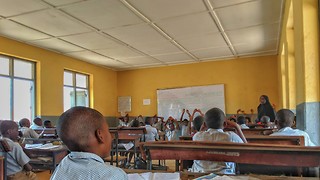Quentin Blake: An Artist Illustrated
Gabrielle Schwarz discusses the career of one of Britain’s best loved artists in the light of his new exhibition at the Fitzwilliam Museum

This week, a new exhibition of Quentin Blake’s recent works opened at the Fitzwilliam Museum. It is expected to be so crowded that the Museum has implemented a timed ticketing system to ensure that the exhibition does not get too crowded. The recognition that Blake is an artist worthy of a standalone exhibition in a big museum seems to demonstrate the singularity of his position as an illustrator. Think about it: if you are asked to name an illustrator, ‘Quentin Blake’ would probably be the first – or even only – one to spring into your head. To reverse the situation, presented with a line-up of images by different illustrators it is Blake’s distinctive style that most people would be able to identify.
Illustration tends to be seen as auxiliary to the words in a story. Worse, they often represent a dumbing down, their target audience being children whose imaginative faculties are not quite up to the job of understanding the text alone. For the grown-up’s sophisticated mental faculties, therefore, illustrations are deemed unnecessary; they impinge upon the writing, removing the reader’s capacity to craft their own interpretations of what the verbal descriptions should look like. This exhibition of Blake’s work quickly proves that he is an exception to the rule that illustrators are subsidiary to writers and lesser than artists. While he may remain famous for being the man who gave form to Roald Dahl’s stories, this exhibition focuses only on his works from the past decade. The majority of them are from independent series of works, or were commissioned for the walls of hospitals and other centres.
Many of these series – Companions, Women with Birds, Girls and Dogs – while retaining that essential, jerky ‘something’ we recognise as so quintessentially Blakean are significant departures from the watercolour wash and ink pen combination we typically associate with his illustrations. Companions is haunting and melancholic in monochromatic chinagraph pencil; Women with Birds experiments with etching; Girls and Dogs uses red-and-black lithographs to create a terrifyingly bloodied landscape. Most surprising, perhaps, are the watercolour pastels on wood painting from a series entitled Big Healthy Girls. Here, a rainbow-coloured naked woman poses against the dark silhouette of the sun and the grassy horizon. Legs planted firmly on the ground with a lunge reminiscent of some yoga position, this woman is serenely static, a far cry from the constantly moving figures that tend to characterise Blake.
The images demonstrate freedom over technique, style and subject matter, which over time Blake’s successful career has afforded him. He has in past interviews stated that while when they first met, Dahl had been precise and controlling over his visions for his characters, towards the end of their partnership, Blake had pretty much free reign over his work: “I remember when I was doing the illustrations for Matilda, Roald told me the way I’d drawn her wasn’t how he’d envisaged her, but then he said, ‘it works so let’s stick with it.’” The display cabinets at the Fitzwilliam do a good job at mythologising the illustrating process, heightening the significance of the tools used (watercolour sets, different brushes and pens, preliminary sketches and exercises) as the instruments of true artists.
At one place in the massive catalogue accompanying the exhibition, there is a quote from Blake recounting an occasion when he was mounting an exhibition in France. He had originally referred to himself in the exhibition’s title as ‘illustrateur’, which the French curators corrected, appropriately, to ‘artiste-dessinateur’. Perhaps Blake stands somewhat alone as the success story of the artist -illustrator. He himself states in the catalogue that ‘indeed the word “illustrator” often has often a sort of tarnish on it’. Despite this statement, Blake has done a lot to demonstrate the potential in the word “illustrator” to one day shine for the imaginative joy it can provide for so many people.
 Comment / Cambridge South is right to be ambitious13 September 2025
Comment / Cambridge South is right to be ambitious13 September 2025 Features / Meet the Cambridge students whose names live up to their degree9 September 2025
Features / Meet the Cambridge students whose names live up to their degree9 September 2025 Features / Cambridge SU: has-been or never-was?16 September 2025
Features / Cambridge SU: has-been or never-was?16 September 2025 News / AstraZeneca pulls £200 million in funding for Cambridge research site15 September 2025
News / AstraZeneca pulls £200 million in funding for Cambridge research site15 September 2025 News / Trinity Street to close for month-long roadworks13 September 2025
News / Trinity Street to close for month-long roadworks13 September 2025








